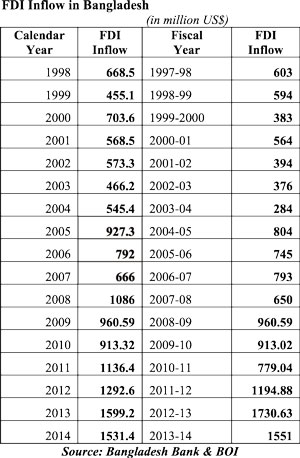
Proactive policy is always important to attract Foreign Direct Investment (FDI), especially in developing countries. But a well-crafted policy alone cannot ensure desired level of FDI. Bangladesh is probably such an example. Despite having a good FDI policy, the inflow of foreign investment in the country is still very low. FDI-GDP ratio in Bangladesh is below 2.0 per cent, while export-GDP ratio is around 18 per cent. Average annual FDI inflow is still below $1.0 billion.
LOWER INFLOW: In fact, it was in 2008 when annual FDI inflow had reached $1.08 billion, crossing the $1 billion mark for the first time in Bangladesh. But in the next year, it dropped to $961 million. In 2011, FDI inflow jumped to $1.13 billion from $913.32 million in 2010. In the next two consecutive years, it continued to increase to $1.3 billion in 2012 and $1.6 billion in 2013 but declined to $1.53billion in the last year.
Inflow of FDI needs to be reviewed in the regional context also. Although Bangladesh is now second in South Asia in FDI inflow to the region, it is far behind India. According to UNCTAD World Investment Report, in 2013 of the total FDI inflow to the region, India alone received around 87 per cent while the share to Bangladesh and Pakistan stood at 4.9 per cent and 4 per cent respectively. But Pakistan's share in inward FDI stood at 10 per cent at the end of 2013 while it is only 3 per cent for Bangladesh.
POLICY OPTIONS: Bangladesh FDI policy is considered quite flexible compared to many other countries. For instance, there is no restriction or limitation on the amount of foreign investment and 100 per cent equity participation is allowed. Only four sectors are not open for FDI. These are: arms and ammunition and other defence equipment and machinery; forest plantation and mechanised extraction within the bounds of reserved forests; production of nuclear energy; and security printing and mining.
Full repatriation of capital invested from foreign sources is allowed and so profits and dividend accruing to foreign investment can be transferred in full. It is also reflected in the official statistics. For example, in 2005, Bangladesh received FDI worth $845.3 million. In the same year, FDI related outward remittance stood at $631 million which included repatriated profits worth $418 million. Thus profit repatriation is not at all a problem in Bangladesh for the multinational corporations.
Again, if foreign investors reinvest their dividends or retained earnings, those are treated as new investments. Foreigners employed in Bangladesh are entitled to remit up to 50 per cent of their salary and also enjoy facilities for full repatriation of their savings and retirement benefits.
Non-resident institutional or individual investors can make portfolio investments in stock exchanges in Bangladesh. Foreign investors or companies may obtain full working loans from local banks.
These are some of the supportive policies for FDI in Bangladesh. Many foreign investors have also appreciated such flexibilities and that's why they are continuing their business in Bangladesh.
KNOWN BARRIERS: Despite supportive policy with lot of facilities, there are some barriers that discourage FDI in Bangladesh. The barriers are not unknown and policy makers are also aware of these.
Inadequate physical infrastructure is a common problem for all kind of investors. Foreign investors find it really difficult to move ahead with poor infrastructure and inadequate power and energy. The road-based communication across the country along with poor rail network has made transportation costly and risky.
Bangladesh's lower ranking in The World Bank's Doing Business index also reflects some unfavourable business conditions in the country and so for FDI. For instance, according to the latest (2014) Doing Business index, on an average it takes 19.5 days in Bangladesh to start a business while it is 11 days in Sri Lanka and 7 days in Afghanistan. It is, however, 19 days in Pakistan and 28.4 days in India. Again, to get electricity connection, it takes around 428.9 days in Bangladesh while it is 105.7 days in India and 178.3 days in Pakistan. There is also the problem of governance as commission and bribery have become critical deterrents in doing business.
In recent times, scarcity of land has become a major impediment to FDI. Some potential foreign investors have gone back as they couldn't get required land. Few years back, there was a move from Samsung Electronics, a multinational company of South Korea, to invest in Bangladesh. Finally, the MNC preferred Vietnam, investing $5 billion to manufacture mobile phone set, as it failed to get land in the Korean Export Processing Zone (KEPZ) in Chittagong. The problem in the KEPZ becomes a unique example of land-related complexity. Not only Samsung, over the years, several foreign investors have come but KEPZ authority failed to provide them plots. It is not because there are no available lands, but because of the government's dilly dallying in transferring land ownership to the KEPZ authority. Some 2,500 acres of land has been allotted to the KEPZ of which around 1,000 acres have so far been developed.
In fact, abnormal price hike of lands bring the opportunity of lucrative business for unscrupulous businessmen wielding political might. They have a tendency to create problem when someone, especially a foreign firm, tries to purchase lands. As land-related legal complexity is very hazardous in Bangladesh, nobody wants to get involved in this.
In order to attract desired level of FDI, land-related complexity needs to be addressed along with other barriers. At a time when the country needs quality FDI, and foreign investors have identified some existing barriers as challenges, new barriers must not jeopardise the situation further.
asjadulk@gmail.com
© 2025 - All Rights with The Financial Express
